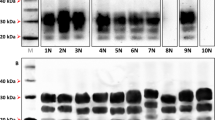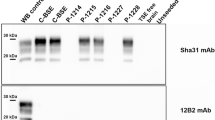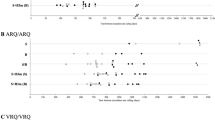Abstract
PREVIOUS work with scrapie led us to conclude1 that the transmissible agent was unlikely to be a conventional virus. We have presented evidence2 that the transmissible agent may be, or may be associated with, a small basic protein (polypeptide) of the kind involved in the production of experimental allergic encephalomyelitis, and we have recorded the possible occurrence of the agent in tissues of normal animals3–5. These observations have neither been confirmed nor disproved in other laboratories and various other hypotheses on the nature of scrapie and its transmissible agent remain unproved6–8. The “slow virus” hypothesis still favoured by some9 is now at variance with the impressive experimental evidence from ultraviolet irradiation studies10–13 that the transmissible agent may not contain nucleic acid.
This is a preview of subscription content, access via your institution
Access options
Subscribe to this journal
Receive 51 print issues and online access
$199.00 per year
only $3.90 per issue
Buy this article
- Purchase on Springer Link
- Instant access to full article PDF
Prices may be subject to local taxes which are calculated during checkout
Similar content being viewed by others
References
Pattison, I. H., J. Comp. Pathol., 75, 159 (1965).
Pattison, I. H., and Jones, K. M., Vet. Rec., 80, 2 (1967).
Pattison, I. H., and Jones, K. M., Nature, 218, 102 (1968).
Pattison, I. H., Path.-Biol., 18, 673 (1970).
Pattison, I. H., Jones, K. M., and Jebbett, J. N., Res. Vet. Sci. (in the press).
Gibbons, R. A., and Hunter, G. D., Nature, 215, 1041 (1967).
Field, E. J., Intern. Rev. Exp. Pathol., 8, 129 (1969).
Adams, D. H., Path.-Biol., 18, 559 (1970).
Gibbs, C. J., and Gajdusek, D. C., Proc. Seventh Intern. Congr. Neuropathol., 779 (1970).
Alper, T., Haig, D. A., and Clarke, M. C., Biochem. Biophys. Res. Commun., 22, 278 (1966).
Alper, T., Cramp, W. A., Haig, D. A., and Clarke, M. C., Nature, 214, 764 (1967).
Haig, D. A., Clarke, M. C., Blum, E., and Alper, T., J. Gen. Virol., 5, 455 (1969).
Latarjet, R., Muel, B., Haig, D. A., Clarke, M. C., and Alper, T., Nature, 227, 1341 (1970).
Carlton, W. W., Toxicol. Appl. Pharmacol., 8, 512 (1966).
Carlton, W. W., Life Sci., 6, 11 (1967).
Carlton, W. W., Exp. Mol. Pathol., 10, 274 (1969).
Author information
Authors and Affiliations
Rights and permissions
About this article
Cite this article
PATTISON, I., JEBBETT, J. Histopathological Similarities between Scrapie and Cuprizone Toxicity in Mice. Nature 230, 115–117 (1971). https://doi.org/10.1038/230115a0
Received:
Issue Date:
DOI: https://doi.org/10.1038/230115a0
This article is cited by
-
Role of the Cellular Prion Protein in the Neuron Adaptation Strategy to Copper Deficiency
Cellular and Molecular Neurobiology (2012)
-
Some unusual high dispersion whistler triplets recorded at a low L-value (L=1.17)
Indian Journal of Physics (2009)
-
Difference in redox behaviors between copper-binding octarepeat and nonoctarepeat sites in prion protein
JBIC Journal of Biological Inorganic Chemistry (2009)
-
The crucial role of metal ions in neurodegeneration: the basis for a promising therapeutic strategy
British Journal of Pharmacology (2005)
-
VLF emissions from ionospheric/magnetospheric plasma
Pramana (2001)
Comments
By submitting a comment you agree to abide by our Terms and Community Guidelines. If you find something abusive or that does not comply with our terms or guidelines please flag it as inappropriate.



